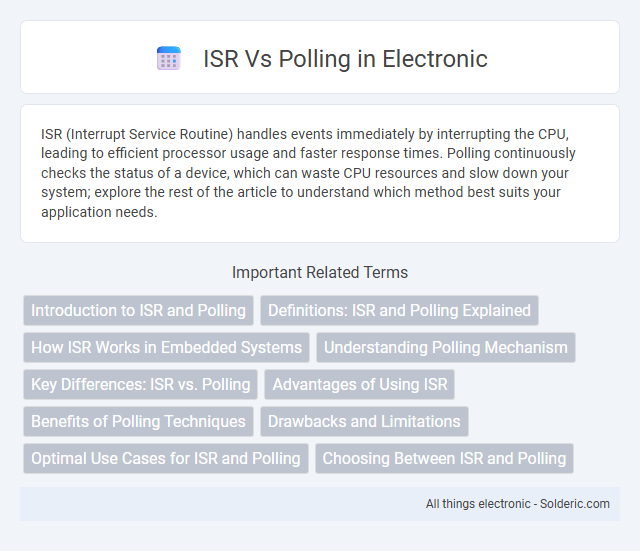ISR (Interrupt Service Routine) handles events immediately by interrupting the CPU, leading to efficient processor usage and faster response times. Polling continuously checks the status of a device, which can waste CPU resources and slow down your system; explore the rest of the article to understand which method best suits your application needs.
Comparison Table
| Feature | Interrupt Service Routine (ISR) | Polling |
|---|---|---|
| Definition | Hardware-triggered function responding to events asynchronously. | CPU repeatedly checks device status in a loop. |
| CPU Utilization | Efficient; CPU processes other tasks until interrupt occurs. | High; CPU busy continuously checking status. |
| Latency | Low; immediate response to events. | Variable; depends on polling interval. |
| Complexity | Higher; requires interrupt setup and handling. | Lower; simpler to implement. |
| Use Case | Time-critical applications requiring immediate attention. | Simple or low-frequency event monitoring. |
Introduction to ISR and Polling
Interrupt Service Routine (ISR) and Polling are two fundamental methods for handling events in embedded systems and real-time applications. ISR operates by responding immediately to hardware interrupts, allowing the processor to attend to other tasks until an event occurs, which maximizes efficiency and responsiveness. Polling, by contrast, constantly checks the status of a device or condition in a loop, which can be simpler to implement but often leads to increased CPU usage and slower reaction times to events.
Definitions: ISR and Polling Explained
Interrupt Service Routine (ISR) is a hardware-driven method where the processor halts current tasks to execute a specific function upon receiving an interrupt signal, enabling immediate response to events. Polling is a software-driven technique where the CPU continuously checks the status of a device or condition in a loop, potentially causing inefficiency due to constant resource usage. ISRs improve efficiency and responsiveness by handling events asynchronously, whereas polling simplifies implementation but may waste processor time.
How ISR Works in Embedded Systems
Interrupt Service Routine (ISR) in embedded systems functions by immediately halting the main program when a specific hardware interrupt occurs, allowing the processor to quickly execute a predefined code segment to handle the event. This mechanism enables real-time response to critical inputs or signals without continuously checking the status of peripherals, minimizing CPU wastage and improving system efficiency. Your embedded application benefits from ISR by achieving faster response times and optimized resource utilization compared to traditional polling techniques.
Understanding Polling Mechanism
Polling mechanism involves the CPU actively checking the status of a peripheral device at regular intervals to determine if it requires attention. This constant querying can lead to wasted processing time and reduced system efficiency compared to interrupt service routines (ISRs), which respond only when a device signals an event. Understanding how polling impacts your system's performance is crucial for optimizing resource management in embedded systems.
Key Differences: ISR vs. Polling
ISR (Interrupt Service Routine) enables immediate processor response to hardware signals, allowing efficient handling of asynchronous events without constant CPU monitoring. Polling requires the CPU to repeatedly check device status, leading to increased CPU usage and potential delays in event processing. Choosing ISR optimizes real-time responsiveness and conserves processing power, while polling may simplify control flow at the cost of performance.
Advantages of Using ISR
Interrupt Service Routines (ISRs) offer significant advantages over polling by enabling immediate response to hardware events, reducing CPU resource consumption and improving system efficiency. ISRs allow your system to remain in low-power states until an interrupt occurs, optimizing power management critical in embedded systems and real-time applications. This approach minimizes latency and ensures timely processing of important tasks, enhancing overall system performance.
Benefits of Polling Techniques
Polling techniques provide a straightforward method for managing device communication by regularly checking the status of peripherals, ensuring your system maintains control over timing and resource allocation. This approach simplifies software design due to its predictable execution flow and is especially effective in scenarios where device response times are consistent and relatively fast. Polling also reduces the complexity associated with interrupt handling, minimizing potential overhead and making it easier to debug and maintain your embedded system.
Drawbacks and Limitations
ISR (Interrupt Service Routine) may introduce latency issues and complexity in real-time systems due to context switching and nested interrupts, which can degrade system performance. Polling continuously consumes CPU resources, reducing efficiency and potentially causing missed events if the polling interval is too long or too short. Your system design must balance these drawbacks, considering factors like response time, CPU load, and system complexity.
Optimal Use Cases for ISR and Polling
Interrupt Service Routines (ISR) are optimal for real-time applications requiring immediate response to events, such as handling hardware interrupts in embedded systems or urgent sensor input processing. Polling is better suited for systems with less frequent or predictable events, where the CPU can intermittently check device status without significant performance overhead, such as in simple control loops or status monitoring tasks. Choosing between ISR and polling depends on balancing responsiveness needs against CPU utilization and system complexity.
Choosing Between ISR and Polling
Choosing between Interrupt Service Routine (ISR) and polling depends on system responsiveness and resource availability. ISR offers efficient CPU utilization by triggering actions only when events occur, ideal for real-time applications requiring low latency. Polling continuously checks system status, suitable for simple tasks with predictable event timing but can lead to higher CPU usage and slower reaction times.
ISR vs Polling Infographic

 solderic.com
solderic.com